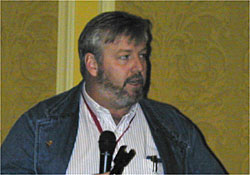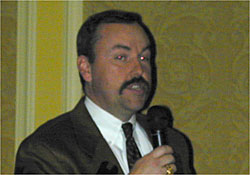

COW-CALF / STOCKER COUNCIL MEETING
2003 Cattle Industry Annual Convention & Trade Show – Nashville, Tennessee
Thursday, January 30, 2003
Sponsored by: Farnam Companies, Incorporated
 |
| "It’s important to keep economics and policy of trade separated," Derrell Peel, Oklahoma State University commented at the cow-calf/stocker council meeting. |
 |
| David Anderson, Texas A&M University, pointed out that when implementing trade into your program it’s important to understand what your individual market is and what your production costs are compared to others. |
Opening Comments
4th Annual "Tagging for Dollars" Program Presentation
Stu Marsh, Marketing Manager, Farnum Companies, Inc.
Audio File
Trade Policy Update
Derrell Peel, Oklahoma State University
Audio File
Implications of Trade Policy for Cow-Calf and Stocker Producers
David Anderson, Texas A&M University
Audio File
Cow-Calf/Stocker Council meeting
At the Cow-Calf/Stocker Council meeting, Farnam Co. Inc. presented the National Cattlemen’s Beef Association (NCBA) with a check for $24,000. Eric Davis, president-elect for NCBA was on hand to thank Farnam for the donation and for their long, continued support and dedication to the industry and to the NCBA.
Two speakers gave a brief overview of trade policy and the implications of trade policy for cow-calf and stocker producers. The first speaker, Derrell Peel, Oklahoma State University, said that the most common things people mix up in trade are the economics and politics. He said the biggest mistake that is made is focusing too quickly on politics without understanding the economics fully. He said that cattle and beef trade reflects market demands and production advantages in trading countries.
Peel emphasized that big beef producing countries are usually major beef producing countries, except for Japan and Australia. Australia exports the majority of beef it produces and Japan imports the majority of its beef.
The five major beef trading countries that export beef, in the order of most to least, are Australia, United States, Brazil, European Union (EU) and Canada. The five major beef importers, in order of most to least, are the United States, Japan, Russia, Mexico and EU. Only two countries, the United States and EU, were in the top five on both lists.
Why does the United States import and export so much beef? The second speaker, David Anderson, Texas A&M University, said that the United States exports a lot of high quality cuts, but that they are starting to export more select, or lower quality cuts to countries like Mexico and Korea. Because of the additional exports, they import ground beef, or select cuts to use in processing.
The implications Anderson gave producers of trade policy were that producing at a lower cost is important. Brazil’s costs of production are 30% lower than the cost in the United States. Producing for a specific market is also critical. The final implication he gave was reducing tariffs in several countries opens up the market for more open trade.
In summary, Anderson said that it is important for producers to understand what your market is and what production costs are compared to others that are competing against you.
— Stephanie Veldman